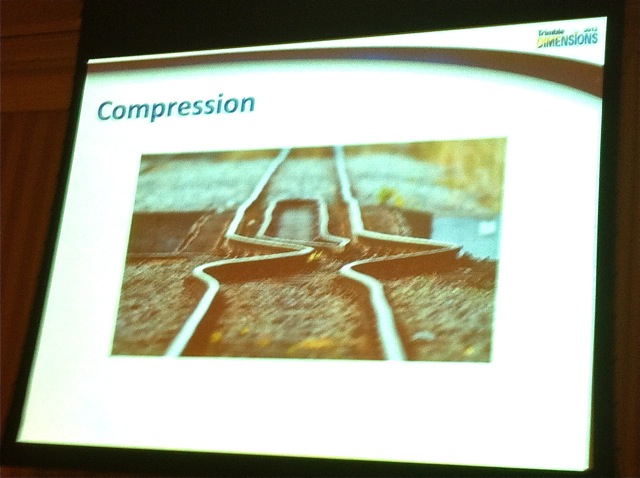As we make final preparations for SPAR Europe here in the Hague, my connection through Newark on the way here has me thinking of how really banged up the New York/New Jersey area is and what a monumental effort the clean-up and re-build will be. It’s something Christchurch, New Zealand, knows a little bit about.
I knew they’d had a couple of large earthquakes, and that the damage was massive, but until hearing from Craig Fraser and Will Newall of Civil Solutionz and Phil Dewar from Fox and Associates at the Trimble event, I really didn’t understand the scope at all. First, I didn’t understand at all the frequency of the seismic activity – they’ve basically had constant earthquakes of at least 3.5 magnitude just about every week (or more often) since the first 7.1 quake on Sept. 4, 2010. More than two years of earthen rattling! And it was the 6.3 quake on Feb. 22, 2011, that really did them in, killing 185 and destroying vast tracts of property.
Craig, Will, and Phil brought the surveyors’ perspective: Imagine a world where all of your survey marks shifted as much as a meter vertically and two meters horizontally. Or, as Craig put it: “All the survey marks are bloody useless! So what do we do now?”
What they did was establish an iBase VRS network RTK system and then resurvey a huge area using only GPS. The end result being quite handy, actually: “Now, effectively, we can do single-point calibration using a geoid model,” Fraser said, “and it couldn’t be any better. We have, right now, a fantastic control network that we can all use.”
It was mostly a survey presentation – they did a bit of scanning, including a mobile scan of the business district largely for posterity – but the real challenging part was figuring out boundary lines and the like in a world where the ground shifted a meter to the left just a few meters from where it shifted a meter to the right!
Check out this train track:

The damage was so vast that a huge portion of the city was deemed completely unfit for habitation. In total, 9,000 properties were evacuated and all the buildings torn down (unless they were down already) and there can be no rebuilding in that area. Looks like this:

Just imagine whole neighborhoods eliminated and ripped apart (and what it must have been like to try to buy a new house after that…).
Really, though, what I want to get to was the way in which Christchurch is going about getting back on its feet. The government has brought together a consortium of the major contractors in New Zealand and enlisted them in a public corporation called SCIRT (for Stronger Christchurch Infrastructure Rebuild Team), which is run in coordination by three of the major government agencies, local, regional, and national. Essentially, if you’re doing work for SCIRT, you hand in your business card at the door and become an employee of the new super-contractor.
Further, if, like Civil Solutionz, you’re doing sub-contracting work for any of those contractors, you also become part of SCIRT and so all of the rebuilding efforts are done collectively and as efficiently as possible. See, the cool part is that the way you get the next job is based on the evaluation of the last job you did.
“It’s all done by KPI (key performance indicators),” Fraser said. “If you’re doing topo, it’s how many meters per hour, and they reward for innovation. Right now we’re the number one survey that SCIRT uses,” he said. “We seem to do more than anyone else in a shift.”
That’s exactly the model I think the Sandy clean-up and re-build effort should adopt. Whether it’s surveyors working on the roads and boardwalks that have been washed away, or the guys actually laying out the new asphalt, the rebuild shouldn’t be some kind of boondoggle where giant companies who’ve given campaign donations get the work, it should be a collective effort so it’s done as efficiently as possible and innovation should be rewarded.
Will that reward the use of laser scanning? Well, if all the hype people like me push around is true, then one would think so, right?
Let’s see what happens, and get those people back on their feet again as soon as possible. They’re still working on it in Christchurch two years later. I’d expect the Sandy clean-up to be a similar task.





